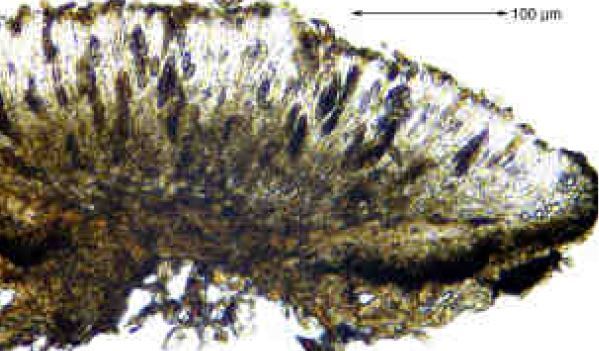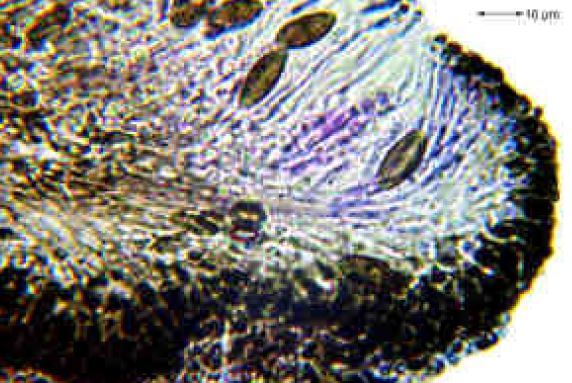Endohyalina ericina (Nyl.) Giralt, van den Boom & Elix
Mycol. Prog., 9: 43, 2010. Basionym: Lecidea ericina Nyl. - Flora, 54: 452, 1878.
Synonyms: Buellia disciformis var. ericina (Nyl.) Boistel; Buellia ericina (Nyl.) Jatta; Rinodina ericina (Nyl.) Giralt; Rinodina madeirensis Kalb & Hafellner
Distribution: S - Pugl (Nimis & Tretiach 1999).
Description: Thallus crustose, episubstratic, areolate-verrucose, whitish to pale grey. Apothecia lecideine, sessile, 0.2-0.5(-0.7) mm across, with a flat to slightly convex, dark brown disc, and a thick, persistent proper margin. Proper exciple 30-45 μm wide laterally, Aethalea-type, the inner hyphae hyaline, prosoplectenchymatous, the outer hyphae parallel and usually strongly brown-pigmented; epithecium brown; hymenium colourless, 50-70 μm high, densely inspersed with oil droplets; paraphyses capitate, the apical cells 3-4(-5) µm wide, with a brown cap; hypothecium dark brown. Asci 8-spored, clavate to cylindrical-clavate, the apical dome K/I+ dark blue with a pale, conical-pointed apical cushion (axial mass), the wall I-, but the thin outer gel I+ blue, Bacidia-type. Ascospores 1-septate, brown with paler spore-ends, fusiform, (10-)11-13(-18) x (4.5-)5-6(-6.5) μm, Dirinaria-type, smooth, without a torus, with ontogeny of type B (apical inner wall-thickenings produced before septum formation). Pycnidia black. Conidia bacilliform, (5-)6-7 x c. 1 μm. Spot tests: thallus K+ yellow, C-, KC-, P+ faintly yellow. Chemistry: diploicin (major), atranorin (minor), isofulgidin (minor), fulgidin (trace) and an unknown substance. Note: on acid bark, more rarely on lignum, in rather shaded and humid situations, with a western distribution in Southern Europe. It is included in the Italian red list of epiphytic lichens as “Endangered” (Nascimbene & al. 2013c). For further details see Giralt (2000).
Growth form: Crustose
Substrata: bark and lignum
Photobiont: green algae other than Trentepohlia
Reproductive strategy: mainly sexual
Most common in areas with a humid-warm climate (e.g. most of Tyrrenian Italy)
Poorly known taxon in need of further study
Commonnes-rarity: (info)
Alpine belt: absent
Subalpine belt: absent
Oromediterranean belt: absent
Montane belt: absent
Submediterranean belt: absent
Padanian area: absent
Humid submediterranean belt: very rare
Humid mediterranean belt: very rare
Dry mediterranean belt: absent
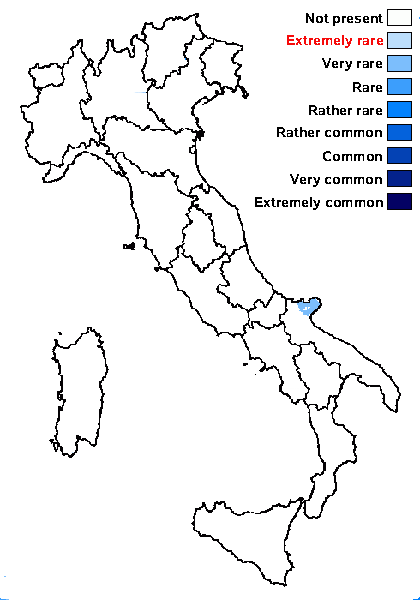
Predictive model
Herbarium samples


Felix Schumm – CC BY-SA 4.0
Image from: F. Schumm (2008) - Flechten Madeiras, der Kanaren und Azoren. Beck, OHG - ISBN: 978-3-00-023700-3
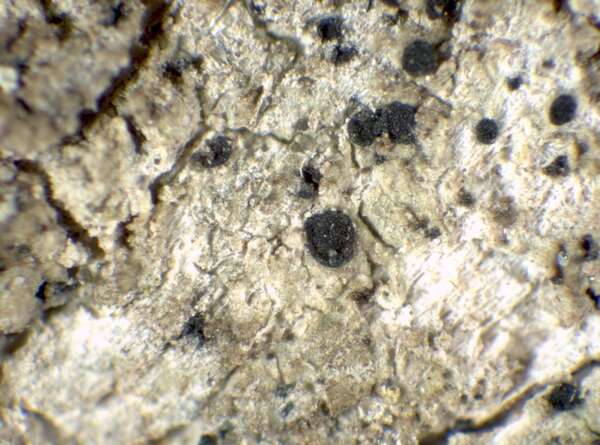

P.L. Nimis; Owner: Department of Life Sciences, University of Trieste
Herbarium: TSB (22967)
2002/01/02
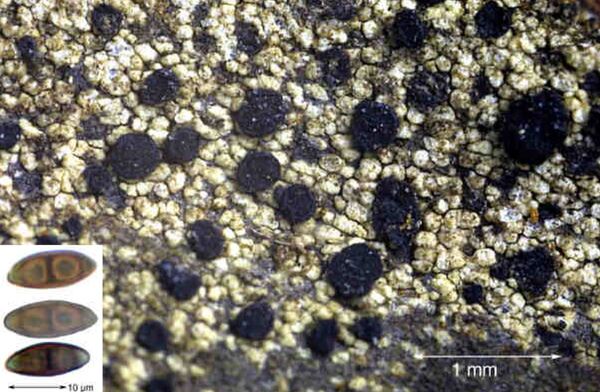

Felix Schumm - CC BY-SA 4.0; Owner: Image from: F. Schumm (2008) - Flechten Madeiras, der Kanaren und Azoren. Beck, OHG - ISBN: 978-3-00-023700-3
Growth form: Crustose
Substrata: bark and lignum
Photobiont: green algae other than Trentepohlia
Reproductive strategy: mainly sexual
Most common in areas with a humid-warm climate (e.g. most of Tyrrenian Italy)
Poorly known taxon in need of further study
Commonnes-rarity: (info)
Alpine belt: absent
Subalpine belt: absent
Oromediterranean belt: absent
Montane belt: absent
Submediterranean belt: absent
Padanian area: absent
Humid submediterranean belt: very rare
Humid mediterranean belt: very rare
Dry mediterranean belt: absent

Predictive model
| Herbarium samples |


Felix Schumm – CC BY-SA 4.0
Image from: F. Schumm (2008) - Flechten Madeiras, der Kanaren und Azoren. Beck, OHG - ISBN: 978-3-00-023700-3


P.L. Nimis; Owner: Department of Life Sciences, University of Trieste
Herbarium: TSB (22967)
2002/01/02


 Index Fungorum
Index Fungorum
 GBIF
GBIF
